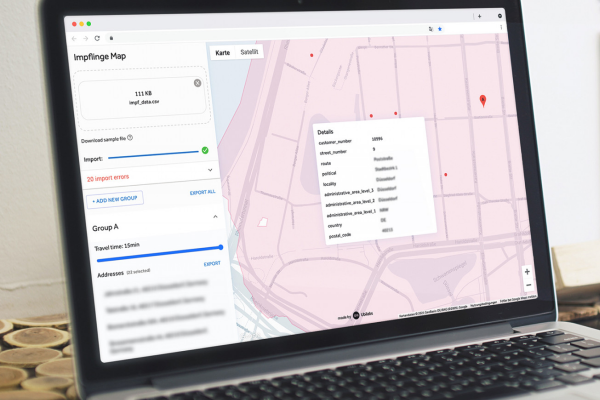
This tool allows for a quick coverage analysis in site planning
Our analysis tool offers the Düsseldorf fire brigade availability analyzes for the rescue service and hazard prevention in seconds instead of months
There should only be a few minutes between the first emergency call and the arrival of the fire and rescue services at the scene.
Therefore, the correct location and distribution of fire and rescue stations is elementary. While plans for new locations used to require lengthy and costly reports from engineering firms, Ubilabs delivered a map-based analysis tool within two months, which provides the basis for decision-making in a matter of seconds for various planning scenarios and simulations.
The response time is the time between the emergency call and the arrival of the fire fighters and rescuers at the scene of the emergency. In many German cities, there is a requirement that the emergency services from the fire brigade arrive at the scene of the emergency no more than ten minutes after the emergency call. For the rescue services even within a maximum of eight minutes.
The distribution of fire and rescue stations based on this is therefore a decisive factor in the location planning of the Dusseldorf fire brigade.
In addition to planning new locations, the redistribution of emergency services in the event of a station failure is an important task for the fire brigade - because every minute counts. However, this task is usually associated with high costs and time-consuming traffic and accessibility analyses. Engineering offices sometimes spend years planning the location of new stations. The high planning and cost effort means that planning scenarios are only carried out at intervals of years.
In 2020, Ubilabs developed an application for vaccination route planning for the Dusseldorf fire brigade. As an experienced consultant and developer for the intelligent use of geodata, it was therefore obvious to shorten this complex process of site planning by developing an individual planning tool for the Düsseldorf fire brigade.
Planning in a matter of seconds by simulating different scenarios
The planning tool enables a quick query of the degree of reachability in the city of Dusseldorf based on various scenarios. In these scenarios, stations can be activated or deactivated, new ones can be added or deleted, and requirements can be set for the response time. For each scenario, the tool calculates the overall degree of reachability in the urban area and shows the degrees with different colors on the map. You can see at a glance which areas will be reached by which percentage in the set time requirements.
If, for example, one of the fire stations is out of action for a long time due to a construction site, a scenario can be set up without this station that determines which areas can still be reached in the desired time and by what percentage. Further simulations can be used to check what effects a new location or the merging of stations or the establishment of a temporary location will have on the reachability. In each scenario, the degree of reachability is calculated and displayed in a bar chart. The bar chart shows how many addresses are reached in which time interval. If the desired time to reach the site is set to eight minutes, a 90% achievement rate indicates that 90% of the addresses in the Dusseldorf metropolitan area can be reached within eight minutes. The tool provides an analysis result in a few seconds instead of months.

The calculation and visualization of reachability
For each location scenario, the tool calculates which of the 83.000 addresses can be reached in the specified time intervals. For the calculation, a request is sent to the targomo API for each location. Based on the route planning of the targomo API, connecting lines are drawn along the times that can be reached from the stations in the same time. These connecting lines, or isochrones, form the grid for classifying the addresses according to the various reachability levels. When planning a route, traffic data such as longer waiting times at traffic lights are omitted from the calculation, since these are emergency vehicle travel times, which have different assumptions than the norm for regular traffic.
The reachabiliry visualization is supported by three different styles of the Mapbox map. You can choose between a reduced style, which makes it easier to see the isochrones, a satellite view and a basic view. The district and district boundaries as well as the isochrones can be shown or hidden, depending on the individual requirements of the users.
Faster decisions in the location planning process
With the help of this data-based application, well-founded decisions can be made in the shortest possible time and questions such as these can be answered: Which locations can be merged, where do we have to build new locations? Can we also cover the area of station A with stations B and C in case of a temporary failure?
The Dusseldorf fire brigade now has a reliable reference to conduct discussions about site planning with the city department of Dusseldorf. And all this at a fraction of the budget previously allocated to planning fire and rescue stations.

